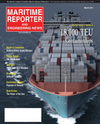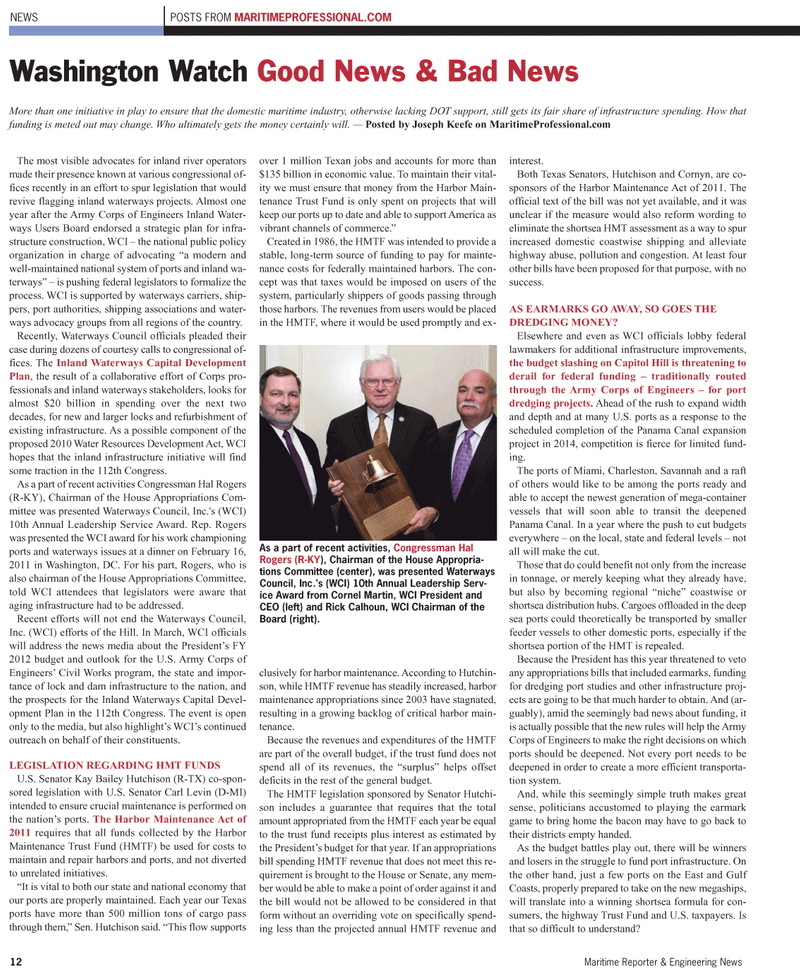
Page 12: of Maritime Reporter Magazine (March 2011)
Ship Repair & Conversion
Read this page in Pdf, Flash or Html5 edition of March 2011 Maritime Reporter Magazine
12 Maritime Reporter & Engineering News
NEWS POSTS FROM MARITIMEPROFESSIONAL.COM
The most visible advocates for inland river operators made their presence known at various congressional of- fices recently in an effort to spur legislation that would revive flagging inland waterways projects. Almost one year after the Army Corps of Engineers Inland Water- ways Users Board endorsed a strategic plan for infra- structure construction, WCI – the national public policy organization in charge of advocating “a modern and well-maintained national system of ports and inland wa- terways” – is pushing federal legislators to formalize the process. WCI is supported by waterways carriers, ship- pers, port authorities, shipping associations and water- ways advocacy groups from all regions of the country.
Recently, Waterways Council officials pleaded their case during dozens of courtesy calls to congressional of- fices. The Inland Waterways Capital Development
Plan, the result of a collaborative effort of Corps pro- fessionals and inland waterways stakeholders, looks for almost $20 billion in spending over the next two decades, for new and larger locks and refurbishment of existing infrastructure. As a possible component of the proposed 2010 Water Resources Development Act, WCI hopes that the inland infrastructure initiative will find some traction in the 112th Congress.
As a part of recent activities Congressman Hal Rogers (R-KY), Chairman of the House Appropriations Com- mittee was presented Waterways Council, Inc.'s (WCI) 10th Annual Leadership Service Award. Rep. Rogers was presented the WCI award for his work championing ports and waterways issues at a dinner on February 16, 2011 in Washington, DC. For his part, Rogers, who is also chairman of the House Appropriations Committee, told WCI attendees that legislators were aware that aging infrastructure had to be addressed.
Recent efforts will not end the Waterways Council,
Inc. (WCI) efforts of the Hill. In March, WCI officials will address the news media about the President’s FY 2012 budget and outlook for the U.S. Army Corps of
Engineers’ Civil Works program, the state and impor- tance of lock and dam infrastructure to the nation, and the prospects for the Inland Waterways Capital Devel- opment Plan in the 112th Congress. The event is open only to the media, but also highlight’s WCI’s continued outreach on behalf of their constituents.
LEGISLATION REGARDING HMT FUNDS
U.S. Senator Kay Bailey Hutchison (R-TX) co-spon- sored legislation with U.S. Senator Carl Levin (D-MI) intended to ensure crucial maintenance is performed on the nation’s ports. The Harbor Maintenance Act of 2011 requires that all funds collected by the Harbor
Maintenance Trust Fund (HMTF) be used for costs to maintain and repair harbors and ports, and not diverted to unrelated initiatives. “It is vital to both our state and national economy that our ports are properly maintained. Each year our Texas ports have more than 500 million tons of cargo pass through them,” Sen. Hutchison said. “This flow supports over 1 million Texan jobs and accounts for more than $135 billion in economic value. To maintain their vital- ity we must ensure that money from the Harbor Main- tenance Trust Fund is only spent on projects that will keep our ports up to date and able to support America as vibrant channels of commerce.”
Created in 1986, the HMTF was intended to provide a stable, long-term source of funding to pay for mainte- nance costs for federally maintained harbors. The con- cept was that taxes would be imposed on users of the system, particularly shippers of goods passing through those harbors. The revenues from users would be placed in the HMTF, where it would be used promptly and ex- clusively for harbor maintenance. According to Hutchin- son, while HMTF revenue has steadily increased, harbor maintenance appropriations since 2003 have stagnated, resulting in a growing backlog of critical harbor main- tenance.
Because the revenues and expenditures of the HMTF are part of the overall budget, if the trust fund does not spend all of its revenues, the “surplus” helps offset deficits in the rest of the general budget.
The HMTF legislation sponsored by Senator Hutchi- son includes a guarantee that requires that the total amount appropriated from the HMTF each year be equal to the trust fund receipts plus interest as estimated by the President’s budget for that year. If an appropriations bill spending HMTF revenue that does not meet this re- quirement is brought to the House or Senate, any mem- ber would be able to make a point of order against it and the bill would not be allowed to be considered in that form without an overriding vote on specifically spend- ing less than the projected annual HMTF revenue and interest.
Both Texas Senators, Hutchison and Cornyn, are co- sponsors of the Harbor Maintenance Act of 2011. The official text of the bill was not yet available, and it was unclear if the measure would also reform wording to eliminate the shortsea HMT assessment as a way to spur increased domestic coastwise shipping and alleviate highway abuse, pollution and congestion. At least four other bills have been proposed for that purpose, with no success.
AS EARMARKS GO AWAY, SO GOES THE
DREDGING MONEY?
Elsewhere and even as WCI officials lobby federal lawmakers for additional infrastructure improvements, the budget slashing on Capitol Hill is threatening to derail for federal funding – traditionally routed through the Army Corps of Engineers – for port dredging projects. Ahead of the rush to expand width and depth and at many U.S. ports as a response to the scheduled completion of the Panama Canal expansion project in 2014, competition is fierce for limited fund- ing.
The ports of Miami, Charleston, Savannah and a raft of others would like to be among the ports ready and able to accept the newest generation of mega-container vessels that will soon able to transit the deepened
Panama Canal. In a year where the push to cut budgets everywhere – on the local, state and federal levels – not all will make the cut.
Those that do could benefit not only from the increase in tonnage, or merely keeping what they already have, but also by becoming regional “niche” coastwise or shortsea distribution hubs. Cargoes offloaded in the deep sea ports could theoretically be transported by smaller feeder vessels to other domestic ports, especially if the shortsea portion of the HMT is repealed.
Because the President has this year threatened to veto any appropriations bills that included earmarks, funding for dredging port studies and other infrastructure proj- ects are going to be that much harder to obtain. And (ar- guably), amid the seemingly bad news about funding, it is actually possible that the new rules will help the Army
Corps of Engineers to make the right decisions on which ports should be deepened. Not every port needs to be deepened in order to create a more efficient transporta- tion system.
And, while this seemingly simple truth makes great sense, politicians accustomed to playing the earmark game to bring home the bacon may have to go back to their districts empty handed.
As the budget battles play out, there will be winners and losers in the struggle to fund port infrastructure. On the other hand, just a few ports on the East and Gulf
Coasts, properly prepared to take on the new megaships, will translate into a winning shortsea formula for con- sumers, the highway Trust Fund and U.S. taxpayers. Is that so difficult to understand?
Washington Watch Good News & Bad News
More than one initiative in play to ensure that the domestic maritime industry, otherwise lacking DOT support, still gets its fair share of infrastructure spending. How that funding is meted out may change. Who ultimately gets the money certainly will. — Posted by Joseph Keefe on MaritimeProfessional.com
As a part of recent activities, Congressman Hal
Rogers (R-KY), Chairman of the House Appropria- tions Committee (center), was presented Waterways
Council, Inc.'s (WCI) 10th Annual Leadership Serv- ice Award from Cornel Martin, WCI President and
CEO (left) and Rick Calhoun, WCI Chairman of the
Board (right).

 11
11

 13
13
